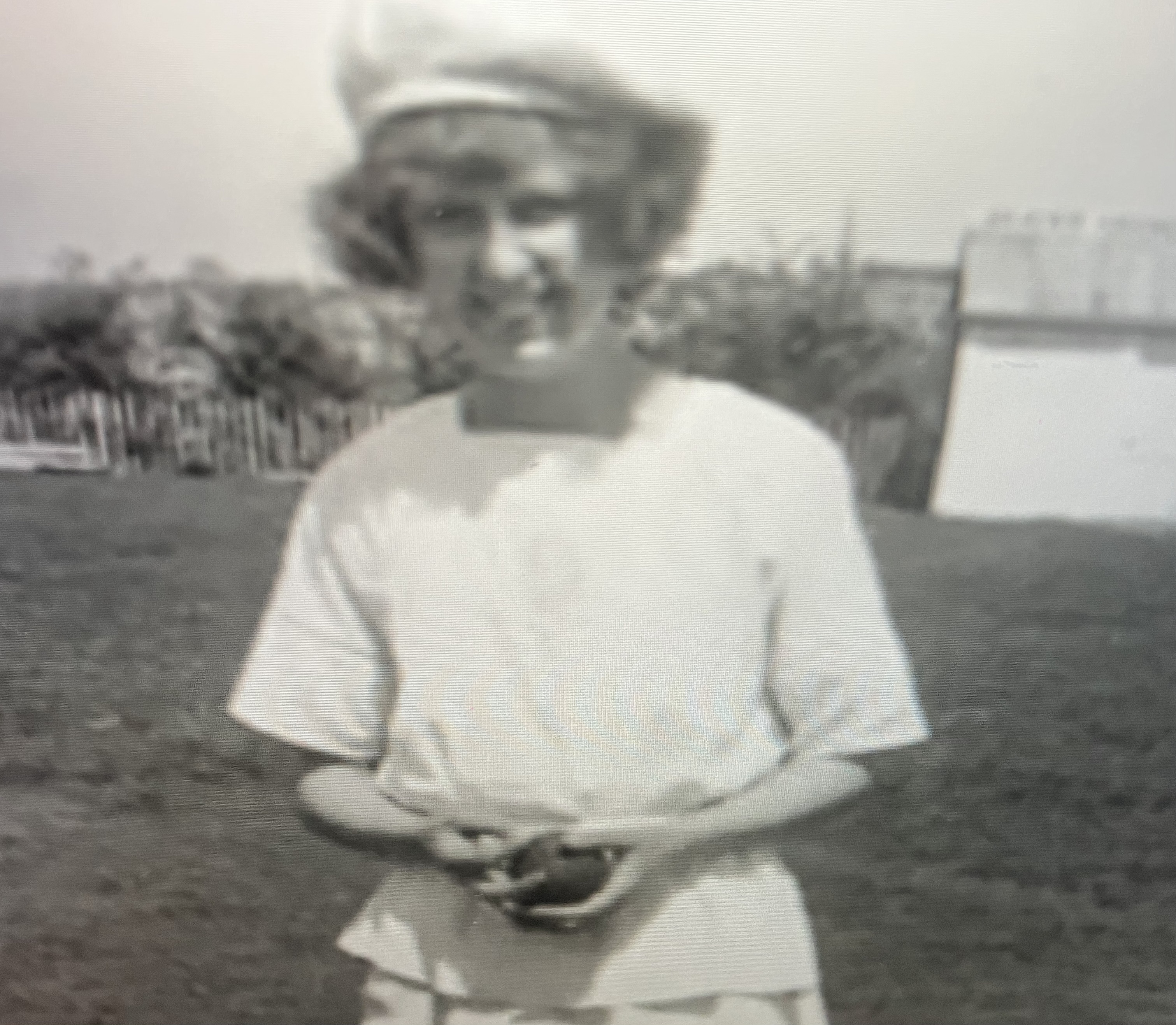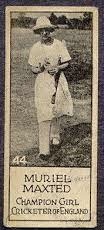In 1922, British Pathé News filmed a young woman called Muriel Maxted batting and bowling in Ashford. (You can find this 55 second clip at https://www.britishpathe.com/asset/49379/). They called her “Doctor Grace In Petticoats”. Yet despite her cricketing fame at the time being enough to attract a national film team to capture her skills for all time, Muriel Maxted’s name is almost completely unknown today. Who was she, and what happened to her?
What the brief clip shows is an 18 year old woman batting and bowling at the now defunct Beaver Cricket Club in Ashford. Muriel’s batting style seems to emulate the famous photograph of Victor Trumper jumping out to drive, while her bowling, off a four pace run, looks more like a First World War infantryman tossing a hand grenade out of his trench in the hope of upsetting a few Germans. Yet her statistics and newspaper coverage at the time are astonishing.
What we know of Muriel Victoria Hannah Maxted is that she was born in Tonbridge on 24th March, 1904. Her father, Edgar Ernest Maxted, was a piano tuner and a keen cricketer, while her mother Hannah (née Pearse), had her hands full with Muriel and her four brothers. Her father took the whole family to Sydney at the end of 1906, where presumably the prospects for a piano tuner were better than at home, but they came back a dozen years later as the war ended, she with a thick Australian accent and a great passion for cricket.
The 1922 Pathé News clip obviously raised Muriel’s profile considerably, as there are many newspaper clippings of her feats over the next few years. In 1923, the West Australian newspaper reported that “Miss Muriel Maxted, Ashford’s girl cricketer, is to make an effort to get into first-class county cricket as a professional…. She has been practising bowling at a secret training quarters, about four miles from the town under the supervision of a South African cricketer who prefers to remain anonymous…. Her trainer declares that he will back her to take the wicket of any batsman in the country in three overs. She practices for two hours every day.” This is real Roy Of The Rovers stuff. No woman has ever played professional cricket with men, and yet a century ago she thought nothing of setting it as her goal. “She is not yet 18 years of age,” the report continues, “but regularly plays with the Beaver Cricket Club, a men’s team, on the same terms as the other players, and thinks nothing of “‘swiping” her male opponents to the boundary. Last season she took 120 wickets at an average cost of two runs each.”

The training sessions were apparently taking place in an old army canteen hut which had been fitted with coconut matting. Her bowling seems to have been the stronger part of her game, with stories of her taking 9 for 10, among other feats. “When she is in form”, her proud Dad is quoted as saying, “she can knock down which of the three stumps she likes four times out of six.” Truly a remarkable cricketer if the newspapers can be believed.
In 1922, as a sign of her fame she was also featured in a newspaper advertisement for Ovaltine, who described her as “Miss Muriel Maxted, the wonderful girl cricketer”. She was quoted as saying that “Quite recently our doctor remarked that it is most surprising that I can stand the stress and strain of a game that makes even strong men tired, and the only explanation of this seems to be the continued use of Ovaltine as my daily beverage.” In 1923 she reportedly took 115 wickets for 179 runs, at the unbelievable average of 1.55, and between 1921 and 1926 she took 561 wickets at 5 runs apiece. Other reports put the figure at 666 wickets.
She was certainly very well known. In 1924, the Willard Chocolate company in Canada produced a series of cards, on the lines of cigarette cards, for their chocolates, which featured 56 famous sportspeople of the world. Many of the names are still well known today – Babe Ruth, Helen Wills Moody, Gene Sarazen, Bill Tilden, Suzanne Lenglen and Johnny Weissmuller for example, but the only cricketer of either sex included in the set was number 44, Muriel Maxted.In that same year, 20 year old Muriel married Eric William King-Turner, a Folkestone based trainee dentist. One of the conditions of the marriage, according to press reports, was that Muriel should be allowed to continue playing cricket under her maiden name. So we assume she did, for a while at least.

By the end of the 1920s, we find a photograph of her with the caption “Folkestone’s Famous Woman Cricketer: Mrs. Muriel King-Turner”, showing her padding up for a net. She is wearing men’s cricket flannels, and blazer and cap, and the Daily Mirror in May 1930 prints another photo of her in flannels, “a pioneer woman cricketer… who has four centuries to her name”. The Sunday Dispatch in March 1931 prints a long article about the proper dress for women cricketers, in which it quotes Muriel as saying, “I prefer to play in flannels because they are more comfortable and give more protection than a skirt.” Her opinion obviously counted, because “as Miss Muriel Maxted, she won fame as a right hand slow bowler.”
She then refers to the newly formed Women’s Cricket Association, adding that the association did not “consider it possible for women to adopt flannels as a regular uniform”. Regardless of the virtues of flannels, skirts or tunics for women cricketers, her mention of the Women’s Cricket Association is interesting. The Association was formed in 1926, after several successful women’s cricket days at Colwall, Herefordshire, which, oddly, never featured Muriel Maxted. Pretty well all of the great women cricketers of the day played every year – players like Betty Snowball and Carol Valentine – but not their spokesperson on cricket gear, “Dr Grace in Petticoats”. She never played there, in flannels, a skirt or petticoats.
Yet the very first match in which a WCA team turned out under the association banner took place at Folkestone on 30 May 1929, between the WCA and Mrs. King-Turner’s XI. In other words, Muriel was sufficiently talented and well-known to be the perfect person to raise a side to play against the newly formed national body of women’s cricket. Obviously an important person in her field, but perhaps not willing to become part of the cricketing establishment. Despite Muriel opening the batting for her XI and scoring 50, the highest individual score of the game, the WCA won that first match by 6 wickets. There is no full record of the bowling analyses, so it is not known if she bowled, but she did not take a wicket. A few weeks later, on 17 July, another WCA-approved game took place at Beckenham, between London and District Women v The Rest. This time Muriel batted at number 7 for London and District, making 19 as her side just held on for a draw. She bowled, but did not take a wicket. Kent’s Carol Valentine was the star of the London and District team, taking 6 for 62 including the hat-trick. These two games seem to be the only record we have of Muriel’s actual achievements. She does not appear anywhere else in the WCA records, nor on Cricket Archive, and in all the books we have checked on women’s cricket, there is no mention of Muriel, either as Miss Maxted or as Mrs King-Turner. She gets no mention in any Wisden, and I have scoured The Cricketer magazine through the 1920s and 1930s without finding any mention of her.
You might think that she slipped into retirement, raised a brood of children and forgot about cricket, but you would be wrong. She and her husband did not have children, and the next we hear of her in the national press is in the Daily Mirror in April 1937. Under the headline, “She Might Give The Aussies More Ashes’, the paper suggested that if the “star Englishwoman cricketer Muriel Maxted “were to accept the Australian women’s cricket team’s invitation to play for them, “odds are ten to one on Australia winning the second Ashes of the season” (after the men had failed to regain them on the 1936/37 tour). The paper suggested that Muriel is eligible to play for the tourists as she spent twelve years of her early life in Australia. The report says that she was widely recognised as the world’s finest woman cricketer, and her inclusion in the Australian side would surely mean victory for the tourists. By this time, Muriel, aged 33, and her husband were living in London, and she was quick to play down the idea. “I don’t think I would like to play against my friends and the old country. Of course, I am half Australian, I suppose, but I’ve played for my county – Kent – so often that I feel I belong here”. In the event, Muriel did not play for either side, and the three match series was drawn 1-1.
So why is there no trace of her in the official women’s cricket records of the time? The answer is that I have no idea. The war came along when Muriel and her husband were living in St Charles Square, Kensington, where we assume her husband’s dental surgery was now based. In the 1939 census, he is described as a dental surgeon, and she as a dental mechanic. On 14th October, 1941, Muriel is recorded as receiving an emergency commission in the Women’s Auxiliary Territorial Service.
Something happened to Eric King-Turner during the war (was he killed? Did they divorce?) and in January 1947, Muriel married for a second time, this time at Winchester to a certain Alexander Engledow, about whom we know little more than his name. Presumably by this time, the 43 year old Muriel had given up playing cricket at a high level. She never seems to have been involved in any cricket administration after retiring as a player, and she has faded completely into the background. She died in Crediton in Devon on October 25th, 1980, aged 76.
Her fame and her pioneering cricket in the 1920s and 1930s deserves to be remembered, as does her and Kent’s part in the development of women’s cricket in the inter-war years. We need to know more. If anybody has any further information on the once famous but now extremely elusive Muriel Maxted, please get in touch. Maybe there are nephews and nieces from her four brothers who remember her, or somebody who has the records of Ashford Beaver CC or Folkestone CC from that era. Please let us know.
With thanks to Ian Phipps and Howard Milton for their help in preparing this article,
0 Comments